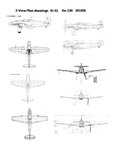As promised in another thread I would move the Ki-61 and He-100 related issue here.
There are many sources over the years citing that the Bf-109 was the inspiration for the creation of the Kawasaki Ki-60 and Ki-61 aircraft. I believe most of this association arises from the initial Intel reports from pilots encountering the Ki-61 reporting it as Japanese built (bought) Messerschmitts or Italian fighters hence the name "Tony" for its identifier code name. Also it uses a Japanese built DB-601 further enhancing the similarity. The Heinkel He-113 wasn't probably in the minds of those pilots making those reports nor had access the Intel files of the He-113.
Next the fact that the Japanese examined and tested the Bf-109E-4 against their own prototypes is well documented adding further weight to those assumptions.
Before continuing on into some evidence that may prove the He-100 was idea into the Ki-61 creation we should look at the timeline of events of this period.
May 1937 – Heinkel Projekt 1035 started
Oct 1937 – RLM informed of Heinkel fighter construction and designation 'He-100' officially allocated.
Jan 1938 – He100v1 first flight
Dec 1938 – Japanese delegation to Marienehe given data/plans on "He-113" (Based A-0 section I aircraft). Five He-100 prototypes flown up to this time.
May 1939 – Hitachi Kokuki K. K. establishes plant in Chiba to license-build the He-100 and He-119. Plans underway to possibly build He-177.
Oct 1939 - Japanese engineering delegation to Marienehe to prepare shipment of He-100 and He-119 to Japan.
Dec 1939 - Koku Hombu creates specification for aircraft built around DB-601
Feb 1940 – Koku Hombu instructs Kawasaki to build two fighter types based on DB-601. Priority given to heavy intercepter (Ki60) and design work begins.
Apr 1940 – DB601 blueprint plans and engines received in Japan.
May 1940 – Three He-100 reach Japan at Kasumigaura, one to IJN and two the Army. (Type A-0 Section II aircraft)
Dec 1940 – Designs started for Ki-61
Mar 1941 – Ki-60 prototype flown with DB601
Jul 1941 – Ha-40 (DB601) begins bench running --Three Bf-109E4 are delivered to Japan
Sep 1941 – Ha-40 pre-series deliveries begin
Nov 1941 – Ha-40 ordered into production
Dec 1941 – Ki-61 prototype flown with Ha-40
Apr 1942 – Lt Umekawa in Ki-61 tries to intercept a B-25 during the "Doolittle raid"
Jun 1942 – Ki-61 Service Trials
The timing of events support the he-100 influence to be more likely than the Bf109
There are many sources over the years citing that the Bf-109 was the inspiration for the creation of the Kawasaki Ki-60 and Ki-61 aircraft. I believe most of this association arises from the initial Intel reports from pilots encountering the Ki-61 reporting it as Japanese built (bought) Messerschmitts or Italian fighters hence the name "Tony" for its identifier code name. Also it uses a Japanese built DB-601 further enhancing the similarity. The Heinkel He-113 wasn't probably in the minds of those pilots making those reports nor had access the Intel files of the He-113.
Next the fact that the Japanese examined and tested the Bf-109E-4 against their own prototypes is well documented adding further weight to those assumptions.
Before continuing on into some evidence that may prove the He-100 was idea into the Ki-61 creation we should look at the timeline of events of this period.
May 1937 – Heinkel Projekt 1035 started
Oct 1937 – RLM informed of Heinkel fighter construction and designation 'He-100' officially allocated.
Jan 1938 – He100v1 first flight
Dec 1938 – Japanese delegation to Marienehe given data/plans on "He-113" (Based A-0 section I aircraft). Five He-100 prototypes flown up to this time.
May 1939 – Hitachi Kokuki K. K. establishes plant in Chiba to license-build the He-100 and He-119. Plans underway to possibly build He-177.
Oct 1939 - Japanese engineering delegation to Marienehe to prepare shipment of He-100 and He-119 to Japan.
Dec 1939 - Koku Hombu creates specification for aircraft built around DB-601
Feb 1940 – Koku Hombu instructs Kawasaki to build two fighter types based on DB-601. Priority given to heavy intercepter (Ki60) and design work begins.
Apr 1940 – DB601 blueprint plans and engines received in Japan.
May 1940 – Three He-100 reach Japan at Kasumigaura, one to IJN and two the Army. (Type A-0 Section II aircraft)
Dec 1940 – Designs started for Ki-61
Mar 1941 – Ki-60 prototype flown with DB601
Jul 1941 – Ha-40 (DB601) begins bench running --Three Bf-109E4 are delivered to Japan
Sep 1941 – Ha-40 pre-series deliveries begin
Nov 1941 – Ha-40 ordered into production
Dec 1941 – Ki-61 prototype flown with Ha-40
Apr 1942 – Lt Umekawa in Ki-61 tries to intercept a B-25 during the "Doolittle raid"
Jun 1942 – Ki-61 Service Trials
The timing of events support the he-100 influence to be more likely than the Bf109
Last edited:


